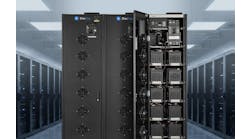Google's Latest Emissions Reporting Discerns Decarbonization Hurdles Amid Data Center, AI Expansion
Issued this month, Google's annual sustainability report zooms in on the scope of the challenge that AI technology's expansion presents for the global energy transition.
As described by the report, Google is investing heavily in sustainability and carbon-free energy, but the rapid growth of AI - and the data centers to support it - is offsetting some of those gains.
The company admits that in 2023, mainly driven by increased data center energy consumption and supply chain emissions, its total GHG emissions increased 13% year-over-year.
As fully stated by the Google Environmental Report 2024, "In 2023, our total GHG emissions increased 13% year-over-year, partially driven by a 37% year-over-year increase in our Scope 2 (market-based) emissions. Our total GHG emissions increased at a slower rate compared to the previous two years."
For trend details for each scope, the report has separate sections for Scope 1 emissions, Scope 2 emissions, and Scope 3 emissions.
Google has been an early mover on many sustainability initiatives, and has built an impressive team that's making meaningful advances in geothermal power and other green technologies, which are outlined in the report.
But AI is growing faster than the supply of renewable energy, and Google's emissions data provides a stark reminder of how much work remains to meet the industry's carbon reduction ambitions.
That would appear to include broader and better sharing of the type of data and progress report that Google has this month released.
Google's Approach to Enabling AI for Sustainability
In a blog post for the company, Google's Chief Sustainability Officer, Kate Brandt, said the latest edition of the annual Environmental Report offers a deep dive into the company's efforts to harness AI technology in particular to drive positive environmental change and sustainable business operations.
To minimize the company's environmental footprint with more efficient infrastructure for the AI era, Brandt's blog notes that Trillium, the company's sixth-generation Tensor Processing Unit (TPU), is over 67% more energy-efficient than its TPU v5e.1
The blog also describes how Google has identified and tested practices its research shows can reduce the energy required to train an AI model by up to 100 times, while reducing associated emissions by up to 1,000 times. Brandt notes that all such practices are currently in use at Google.
Brandt also recounts how Google's energy-efficient computing infrastructure is supported by responsible water use practices and a commitment to minimizing waste.
According to the company, a Google-owned and -operated data center is, on average, approximately 1.8 times as energy efficient as a typical enterprise data center.
The blog further states that in 2023, average annual power usage effectiveness for Google data centers was 1.10 compared with the industry average of 1.58 - meaning that Google's data centers used about 5.8 times less overhead energy for every unit of IT equipment energy.
Additionally, Brandt notes how Google has introduced a water risk framework to further identify climate-conscious cooling solutions that consider carbon-free energy (CFE) availability, watershed health and future water needs.
"We see our growing infrastructure as an opportunity to drive the innovations and investments needed to power a low-carbon economy," adds Google's Brandt.
How Google Is Driving Sustainability Across Its Operations
In 2017, Google became the first major company to match 100% of its annual electricity consumption on a global basis with renewable energy, a benchmark which Brandt notes the hyperscaler has achieved every year since.
2020 marked Google's third decade of climate action, with a bold goal to reach net-zero emissions across its entire operations and value chain by 2030.
This ambition is supported by the company's goal to run on 24/7 CFE on every grid where it operates.
Brandt's blog noted the company is also working to advance water stewardship, build a circular economy, and restore and enhance nature and biodiversity.
According to the Google Environmental Report 2024, the company's progress across such areas includes the following data points:
- 10 of the company's grid regions achieved at least 90% CFE last year. Plus, even with the total electricity load increasing across its data centers, Google maintained a global average of 64% CFE. The report also noted Google's enhanced geothermal project which is now delivering CFE to the grid.
- Over the past year, Google signed contracts to purchase approximately 4 gigawatts (GW) of clean energy generation capacity (more than in any prior year) in locations such as Texas, Belgium and Australia.
- The company recently implemented the Google Renewable Energy Addendum, which asks its largest hardware manufacturing suppliers, based on spending, to commit to achieving a 100% renewable energy match by 2029.
- The report notes that Google's water stewardship projects replenished an estimated 1 billion gallons of water, which represents 18% of the company's 2023 freshwater consumption and triple its replenishment progress of 6% in 2022.
It's Hard to Decarbonize
Addressing the reality of the company's total GHG emissions increasing 13% year-over-year on the back of increased data center energy consumption and supply chain emissions, Google CSO Brandt admitted, "In spite of the progress we are making, we face significant challenges that we’re actively working through."
To conclude her blog, Brandt further admits how while Google has advanced clean energy on many of the grids where it operates, hard-to-decarbonize regions such as Asia-Pacific still loom where CFE isn't readily available.
Brandt also noted how the company often sees longer lead times between initial investments and construction of clean energy projects, and the resulting GHG reductions from them.
To continue to drive progress toward a low-carbon economy, Brandt notes how Google recently introduced a clean transition rate that brings customers and utilities together to drive new clean energy projects in the U.S., and also recently unveiled an investment to enable 1 GW of new solar capacity in Taiwan.

Matt Vincent
A B2B technology journalist and editor with more than two decades of experience, Matt Vincent is Editor in Chief of Data Center Frontier.





